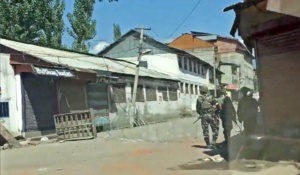"Most narratives about Kashmir that TV studios push down our throats are without letting Kashmiris speak. Where are the ground reports from the valley that tell the real concerns of the people?" Nadiya Shafi, our community correspondent from Srinagar, writes about the clampdown in Kashmir.

August 2019 was a month of emotional roller-coaster rides. I was getting married to the person I love after facing many challenges. I was happy and relieved. But, as most Kashmiris' will attest to, our happiness can quickly come to a halt if the Indian state so decides. On the 1st of August, a day before of my marriage, an additional contingent of 28,000 security personnel were deployed in Kashmir. The tension was palpable amongst the people in the town - everyone was extremely scared, they were rushing to stock up food. Phones were busy with people trying to contact all their beloved. The groom and his family were to come to my house for the nikaah at 7 pm.
No one knew, or, I should say no one told us the reason for this amount of security beef up, but most people conjectured that the Indian government intended to demolish Article 370. The director of the organisation I work for was in the car with my soon-to-be husband, traveling to my house for the nikaah. He spent the entire two-hour journey trying to book a flight out of Kashmir before things went really bad. Many of our guests were in a similar situation - they all wanted to get out of the valley and be back with their dear ones.
And they were right - on August 4th, around 10 pm, everything got shut down and yet there was no communication about the reason. The news finally got confirmed the next day via radio and the worst fear of a Kashmiri came true. The Government of India had scrapped 370!
Today, 54 days later, the lockdown continues and everyone is still caged in their houses with heavily armed military persons watching our lanes and streets that are strewn with razor-wire fences. The fear in every heart and a forced 'calm' continues. We are unaware of what’s happening in the house next door. Parents are worried sick of their children who live outside the valley, day earners are unable to earn a living for their families. The sick and old cannot get to the hospital and lots of casualties have happened. Children cannot go to school and even if they could, parents are concerned about their security. If they do send them to school there's no way to find out if they would make it safely back. The scarcity of food and medicines, the restrictions on mobility and the continuing blackout of cellphones and the internet has made it difficult for the Kashmiris to survive.
Those who have some money can buy food early in the morning as a few shops open for 2 to 3 hours in the morning. But those who depend on daily wages are unable to feed their families. One source of income in the valley is the business of fruits, but unpicked fruits are rotting on trees. Deserted roads, uncertainty and hundreds of arrests in every corner of Kashmir are what details the current situation. No one is safe.
We are told that “all is well”. According to blinkered newsroom anchors and politicians, there are only a few who resist the abrogation of 370 and they claim that the majority are fine with the decision. How do they know this? Most narratives about Kashmir that TV studios push down our throats are without letting Kashmiris speak. Where are the ground reports from the valley that tell the real concerns and opinions of the people? If everything is fine, why is the curfew still on? If everything is fine, why is the government not lifting the ban on communications and let people voice their opinions? These are rhetorical questions because we know the truth - the Kashmiri's desire for freedom from oppression and forceful occupation has not eroded. If anything, that desire has only gotten stronger. The Indian state is too fearful to let this truth out and that explains the clamp-down.
I had to wait to get out of Kashmir to publish this. And since the day I got out, 8 days back, I have not been able to connect with my family and friends back home.
Article by Nadiya Shafi, VV's Community Correspondent from Srinagar
Livelihood at stake in Chatra
The matter is serious - in Jatrahi village under Sikid village council of Chatra Block, Chatra District of Jharkhand, 25 families of Bhuyan community were living for 70 years and they are asked to relocate.
Qaleen Baafi: Diminutive Art
Kashmir carpet is famous throughout the world. Germany is the largest consumer of Kashmiri carpet, the country’s cold winters make it an ideal destination for the use of Kashmir Shawls, rugs and carpets. Kashmiri carpets are considered to be the finest carpets in the world second only to Persian carpets.
